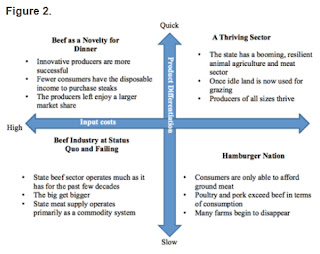Scenario planning is an important part of business strategic planning. In agriculture, scenario planning is even more important given the number of variables and the level of uncertainty associated with production. Within the field of agriculture, scenario planning is a part of strategic planning where the business imagines how different organizational decisions may be played out to show possible futures.
For scenario planning producers should focus on primary questions surrounding the industry. For example, “What will the state’s beef industry look like in the year 2025?” Then the question of “What might we need to do?” in this situation be considered. From these focal questions a list of possible scenarios can be created. Continuing with the example from above “If we are faced with an increase in the price of inputs, what could happen to the cost of weight gain?”, and “If consumers are to change their attitude and perception of point of production origin for beef, what changes in business practices (product traceability) must occur?”
After discussing possible futures, a diagram can be used where two uncertainties at two different levels can be compared with different future out comes (figure 1). The manager can look at different outcomes in terms of quadrants. In figure 1, the first quadrant (right top) is the preferred future, the second quadrant (left top) is the expected future, the third quadrant (left bottom) is the second alternative future, and the fourth quadrant (right bottom) is the least preferred or feared outcome.
Continuing with the example from above a visual depiction of four possible futures with varying, plausible, probable, and preferred outcomes can be created. Figure 2 is broken down into different quadrants. The first quadrant contains the preferred outcome or where the market is thriving and the state has a booming agriculture meat sector. The second quadrant contains the most likely outcome where fewer producers exist and beef becomes more of a novelty. The third quadrant contains a less likely alternative where the beef industry in the state operates the same way it has in the past, large producers continue increasing in size and scale, and meat suppliers operate in a commodity system. The fourth quadrant is the worst case scenario in which the majority of consumers purchase only ground beef with poultry and pork exceeding beef consumption, and many farms begin to disappear.
This example shows different possible outcomes for the state’s beef industry. Through the use of scenario framework development producers, managers, and suppliers of agriculture products can identify and evaluate potential, conceivable, and preferred futures. Once a preferred future is discovered, a framework for present day decision making can be used to guide the decision maker to the preferred outcome.
Original Article Here


No comments:
Post a Comment